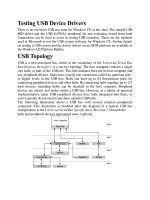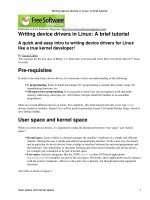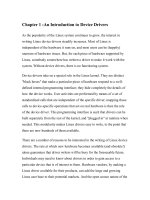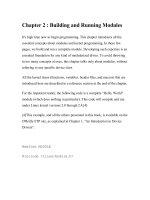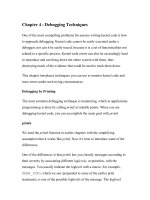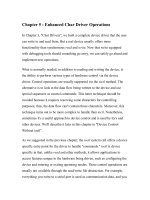Com Programming Guide for Linux USB device drivers
Bạn đang xem bản rút gọn của tài liệu. Xem và tải ngay bản đầy đủ của tài liệu tại đây (1.64 MB, 109 trang )
Programming Guide for Linux USB Device Drivers
Next: Preface Up: USB Developer Pages Contents Index
Programming Guide for Linux USB
Device Drivers
(c) 2000 by Detlef Fliegl
$Id: usbdoc.tex,v 1.32 2000/12/25 18:36:26 deti Exp $
This document can be found on and can be downloaded from
/>This document may not be published, printed or used in excerpts without explicit permission of the
author.
●
●
●
●
●
Preface
Contents
List of Figures
The Universal Serial Bus
❍ Host Controllers
❍ USB Devices and Transfer Characteristics
■ Hubs
■ Data Flow Types
❍ Enumeration and Device Descriptors
■ Standard Descriptors
■ Device Classes
■ Human Interface Devices (HID)
❍ USB Device Drivers
The Linux USB Subsystem
❍ The USB Device Driver Framework
■ Framework Data Structures
■ Framework Entry Points
■ Framework Functions
❍ Configuring USB Devices
(1 of 2) [18/07/2003 10:56:40]
Programming Guide for Linux USB Device Drivers
Descriptor Data Structures
■ Standard Device Requests
❍ USB Transfers
■ Transfer Data Structures & Macros
■ URB Functions
■ URB Macros
■ Compatibility Wrappers
❍ Examples
Reference
❍ Error Codes
■ Error codes returned by usb_submit_urb
■ URB Error Codes
■ Error Codes returned by USB Core Functions
Bibliography
Index
About this document ...
■
●
●
●
●
Detlef Fliegl
2001-01-08
(2 of 2) [18/07/2003 10:56:40]
Preface
Next: Contents Up: Programming Guide for Linux Previous: Programming Guide for Linux Contents
Index
Preface
The development of the Linux USB subsystem started in 1997 and in the meantime it was redesigned
many times. This implied various changes of its internal structure and its API too. So it is even hard for
experienced device driver developers to keep up to date with all ongoing discussions and current
changes.
This document should give detailed information about the current state of the USB subsystem and its API
for USB device drivers. The first section will deal with the basics of USB devices. You will learn about
different types of devices and their properties. Going into detail you will see how USB devices
communicate on the bus. The second section gives an overview of the Linux USB subsystem [2] and the
device driver framework. Then the API and its data structures will be explained step by step. The last
section of this document contains a reference of all API calls and their return codes.
Detlef Fliegl
2001-01-08
[18/07/2003 10:56:48]
USB Project
Institut für Informatik TU-München
Lehr- und Forschungseinheit Informatik X
Lehrstuhl für Rechnertechnik und
Rechnerorganisation/Parallelrechner
Prof. Dr. A. Bode
Universal Serial Bus Development for Linux
G. Acher & D. Fliegl & T. Sailer & R. Weissgärber
for
(1 of 2) [18/07/2003 10:56:50]
USB Project
●
●
●
●
Programming Guide for Linux USB Device Drivers
People
Related Sites / Links
Download
USB-Team, $Date: 2000/03/14 22:29:01 $
(2 of 2) [18/07/2003 10:56:50]
Contents
Next: List of Figures Up: Programming Guide for Linux Previous: Preface Index
Contents
●
Programming Guide for Linux USB Device Drivers
❍ Contents
❍ List of Figures
❍ The Universal Serial Bus
■ Host Controllers
■ USB Devices and Transfer Characteristics
■ Enumeration and Device Descriptors
■ USB Device Drivers
❍ The Linux USB Subsystem
■ The USB Device Driver Framework
■ Configuring USB Devices
■ USB Transfers
■ Examples
❍ Reference
■ Error Codes
❍ Bibliography
❍ Index
Detlef Fliegl
2001-01-08
[18/07/2003 10:56:50]
Index
Next: About this document ... Up: Programming Guide for Linux Previous: Bibliography Contents
Index
actual_length
Transfer Data Structures & | Transfer Data Structures &
bulk transfers
Data Flow Types
bus powered
USB Devices and Transfer
communication speed
USB Devices and Transfer
compatibility wrappers
Compatibility Wrappers
complete
Transfer Data Structures &
configuration descriptor
Standard Descriptors
context
Transfer Data Structures &
control transfers
Data Flow Types
dev
Transfer Data Structures &
device classes
Device Classes
device descriptor
Standard Descriptors
disconnect function
Framework Entry Points
downstream
Data Flow Types
driver framework
The USB Device Driver
endpoint descriptor
Standard Descriptors
entry points
(1 of 6) [18/07/2003 10:56:52]
Index
Framework Entry Points
enumeration
Enumeration and Device Descriptors
Error Codes
Error Codes
error_count
Transfer Data Structures &
FILL_BULK_URB
URB Macros
FILL_BULK_URB_TO
URB Macros
FILL_CONTROL_URB
URB Macros
FILL_CONTROL_URB_TO
URB Macros
FILL_INT_URB
URB Macros
framework
The USB Device Driver
full speed
USB Devices and Transfer
HID
Human Interface Devices (HID)
Host Controller
Host Controllers
hub
Hubs
human interface devices
Human Interface Devices (HID)
interface descriptor
Standard Descriptors
interrupt transfers
Data Flow Types
interval
Transfer Data Structures &
iso_frame_desc
Transfer Data Structures &
isochronous transfers
Data Flow Types
linux USB subsystem
The Linux USB Subsystem
(2 of 6) [18/07/2003 10:56:52]
Index
low speed
USB Devices and Transfer
macros
URB Macros
next
Transfer Data Structures &
number_of_packets
Transfer Data Structures &
OHCI
Host Controllers
pipe
Transfer Data Structures &
probe function
Framework Entry Points
self powered
USB Devices and Transfer
setup_packet
Transfer Data Structures &
specification
The Universal Serial Bus
start_frame
Transfer Data Structures & | Transfer Data Structures &
status
Transfer Data Structures &
string descriptors
Standard Descriptors
struct usb_config_descriptor
Descriptor Data Structures
struct usb_device
Descriptor Data Structures
struct usb_endpoint_descriptor
Descriptor Data Structures
struct usb_interface
Descriptor Data Structures
struct usb_interface_descriptor
Descriptor Data Structures
timeout
Transfer Data Structures &
transfer_buffer
Transfer Data Structures &
transfer_buffer_length
(3 of 6) [18/07/2003 10:56:52]
Index
Transfer Data Structures &
transfer_flags
Transfer Data Structures &
UHCI
Host Controllers
Universal Serial Bus
The Universal Serial Bus
upstream
Data Flow Types
USB
The Universal Serial Bus
USB core
The Linux USB Subsystem
USB subsystem
The Linux USB Subsystem
usb_alloc_urb
URB Functions
USB_ASYNC_UNLINK
Transfer Data Structures &
usb_bulk_msg
Compatibility Wrappers
usb_clear_halt
Standard Device Requests
usb_control_msg
Compatibility Wrappers
usb_deregister
Framework Functions
USB_DISABLE_SPD
Transfer Data Structures &
usb_driver_claim_interface
Framework Functions
usb_driver_release_interface
Framework Functions
usb_free_urb
URB Functions
usb_get_descriptor
Standard Device Requests
usb_get_device_descriptor
Standard Device Requests
usb_get_protocol
Standard Device Requests
(4 of 6) [18/07/2003 10:56:52]
Index
usb_get_report
Standard Device Requests
usb_get_status
Standard Device Requests
usb_get_string
Standard Device Requests
usb_interface_claimed
Framework Functions
USB_ISO_ASAP
Transfer Data Structures &
USB_NO_FSBR
Transfer Data Structures &
USB_QUEUE_BULK
Transfer Data Structures &
usb_rcvbulkpipe
Transfer Data Structures &
usb_rcvctrlpipe
Transfer Data Structures &
usb_rcvintpipe
Transfer Data Structures &
usb_rcvisopipe
Transfer Data Structures &
usb_register
Framework Functions
usb_set_configuration
Standard Device Requests
usb_set_idle
Standard Device Requests
usb_set_interface
Standard Device Requests
usb_set_protocol
Standard Device Requests
usb_sndbulkpipe
Transfer Data Structures &
usb_sndctrlpipe
Transfer Data Structures &
usb_sndintpipe
Transfer Data Structures &
usb_sndisopipe
Transfer Data Structures &
usb_string
(5 of 6) [18/07/2003 10:56:52]
Index
Standard Device Requests
usb_submit_urb
URB Functions
USB_TIMEOUT_KILLED
Transfer Data Structures &
usb_unlink_urb
URB Functions
virtual root hub
Hubs
Detlef Fliegl
2001-01-08
(6 of 6) [18/07/2003 10:56:52]
List of Figures
Next: The Universal Serial Bus Up: Programming Guide for Linux Previous: Contents Contents
Index
List of Figures
1.
2.
3.
4.
5.
6.
7.
8.
USB Topology
USB Descriptor Hierarchy
USB Core API Layers
usb_driver structure
A simple probe function
A simple disconnect function
URB Structure
A simple completion handler
Detlef Fliegl
2001-01-08
[18/07/2003 10:56:53]
The Universal Serial Bus
Next: Host Controllers Up: Programming Guide for Linux Previous: List of Figures Contents Index
The Universal Serial Bus
In 1994 an alliance of four industrial partners (Compaq, Intel, Microsoft and NEC) started to specify the
Universal Serial Bus (USB). The bus was originally designed with these intentions:
●
●
●
Connection of the PC to the telephone
Ease-of-use
Port expansion
The specification (version 1.0) was first released in january 1996 and the latest official version 1.1 was
released in september 1998 [4]. The document is still under development and a version 2.0 was
announced in 1999. More information and all specification papers can be found in [1]. The USB is
strictly hierarchical and it is controlled by one host. The host uses a master / slave protocol to
communicate with attached USB devices. This means that every kind of communication is initiated by
the host and devices cannot establish any direct connection to other devices. This seems to be a drawback
in comparison to other bus architectures but it is not because the USB was designed as a compromise of
costs and performance. The master / slave protocol solves implicitly problems like collision avoidance or
distributed bus arbitration. The current implementation of the USB allows 127 devices to be connected at
the same time and the communication bandwidth is limited to 12Mbit/s.
Subsections
●
●
●
●
Host Controllers
USB Devices and Transfer Characteristics
❍ Hubs
❍ Data Flow Types
Enumeration and Device Descriptors
❍ Standard Descriptors
❍ Device Classes
❍ Human Interface Devices (HID)
USB Device Drivers
(1 of 2) [18/07/2003 10:56:53]
The Universal Serial Bus
Next: Host Controllers Up: Programming Guide for Linux Previous: List of Figures Contents Index
Detlef Fliegl
2001-01-08
(2 of 2) [18/07/2003 10:56:53]
Host Controllers
Next: USB Devices and Transfer Up: The Universal Serial Bus Previous: The Universal Serial Bus
Contents Index
Host Controllers
Today the USB host controller is integrated on most motherboard chipsets. Older boards which are not
equipped with such a controller can be upgraded by PCI cards with such host controllers. All these
controllers are compatible with either the Open Host Controller Interface (OHCI by Compaq, Microsoft
and National Semiconductor) or the Universal Host Controller Interface (UHCI by Intel [7]) standard.
Both types have the same capabilities and USB devices do not have to care about the host controller.
Basically the hardware of UHCI is simpler and therefore it needs a more complex device driver, which
could cause slightly more CPU load.
Detlef Fliegl
2001-01-08
[18/07/2003 10:56:54]
USB Devices and Transfer Characteristics
Next: Hubs Up: The Universal Serial Bus Previous: Host Controllers Contents Index
USB Devices and Transfer Characteristics
There are different types of USB devices as they can be used for different purposes. First a device can be
self powered, bus powered or both. The USB can provide a power supply up to 500mA for its devices. If
there are only bus powered devices on the bus the maximum power dissipation could be exceeded and
therefore self powered devices exist. They need to have their own power supply. Devices that support
both power types can switch to self powered mode when attaching an external power supply.
Even the maximum communication speed can differ for particular USB devices. The USB specification
decides between low speed and full speed devices. Low speed devices (such as mice, keyboards,
joysticks etc.) communicate at 1.5MBit/s and have only limited capabilities. Full speed devices (such as
audio and video systems) can use up to 90% of the 12Mbit/s which is about 10Mbit/s including the
protocol overhead.
Figure 1:USB Topology
(1 of 2) [18/07/2003 10:56:54]
USB Devices and Transfer Characteristics
Subsections
●
●
Hubs
Data Flow Types
Next: Hubs Up: The Universal Serial Bus Previous: Host Controllers Contents Index
Detlef Fliegl
2001-01-08
(2 of 2) [18/07/2003 10:56:54]
Hubs
Next: Data Flow Types Up: USB Devices and Transfer Previous: USB Devices and Transfer Contents
Index
Hubs
Physically there exist a number of USB ports at the rear panel of a computer. These ports can be used to
attach normal devices or a hub. A hub is a USB device which extends the number of ports (i.e. 2-8) to
connect other USB devices. The maximum number of attachable devices is reduced by the number of
hubs on the bus. Hubs are self- and/or bus powered full speed devices.
Normally the physical ports of the host controller are handled by a virtual root hub. This hub is simulated
by the host controller's device driver and helps to unify the bus topology. So every port can be handled in
the same way by the USB subsystem's hub driver (see figure 1).
Detlef Fliegl
2001-01-08
[18/07/2003 10:56:55]
Data Flow Types
Next: Enumeration and Device Descriptors Up: USB Devices and Transfer Previous: Hubs Contents
Index
Data Flow Types
The communication on the USB is done in two directions and uses 3 different transfer types. Data
directed from the host to a device is called downstream or OUT transfer. The other direction is called
upstream or IN transfer. Depending on the device type different transfer variants are used:
●
Control transfers are used to request and send reliable short data packets. It is used to configure
devices and every one is required to support a minimum set of control commands. Here is a list of
standard commands:
❍ GET_STATUS
❍ CLEAR_FEATURE
❍ SET_FEATURE
❍ SET_ADDRESS
❍ GET_DESCRIPTOR
❍ SET_DESCRIPTOR
❍ GET_CONFIGURATION
❍ SET_CONFIGURATION
❍ GET_INTERFACE
❍ SET_INTERFACE
❍ SYNCH_FRAME
Further control commands can be used to transfer vendor specific data.
●
●
●
Bulk transfers are used to request or send reliable data packets up to the full bus bandwidth.
Devices like scanners or scsi adapters use this transfer type.
Interrupt transfers are similar to bulk transfers which are polled periodically. If an interrupt
transfer was submitted the host controller driver will automatically repeat this request in a
specified interval (1ms - 255ms).
Isochronous transfers send or receive data streams in realtime with guaranteed bus bandwidth
but without any reliability. In general these transfer types are used for audio and video devices.
(1 of 2) [18/07/2003 10:56:55]
Data Flow Types
Next: Enumeration and Device Descriptors Up: USB Devices and Transfer Previous: Hubs Contents
Index
Detlef Fliegl
2001-01-08
(2 of 2) [18/07/2003 10:56:55]
Enumeration and Device Descriptors
Next: Standard Descriptors Up: The Universal Serial Bus Previous: Data Flow Types Contents
Index
Enumeration and Device Descriptors
Whenever a USB device is attached to the bus it will be enumerated by the USB subsystem - i.e an
unique device number (1-127) is assigned and then the device descriptor is read. Such a desciptor is a
data structure which contains information about the device and its properties. The USB standard defines
a hierarchy of descriptors (see figure 2).
Figure 2:USB Descriptor Hierarchy
Subsections
●
●
●
Standard Descriptors
Device Classes
Human Interface Devices (HID)
(1 of 2) [18/07/2003 10:56:56]
Enumeration and Device Descriptors
Detlef Fliegl
2001-01-08
(2 of 2) [18/07/2003 10:56:56]
Standard Descriptors
Next: Device Classes Up: Enumeration and Device Descriptors Previous: Enumeration and Device
Descriptors Contents Index
Standard Descriptors
●
●
●
A Device Descriptor describes general information about a USB device. It includes information
that applies globally to the device and all of the device's configurations. A USB device has only
one device descriptor.
The Configuration Descriptor gives information about a specific device configuration. A USB
device has one or more configuration descriptors. Each configuration has one or more interfaces
and each interface has zero or more endpoints. An endpoint is not shared among interfaces within
a single configuration unless the endpoint is used by alternate settings of the same interface.
Endpoints may be shared among interfaces that are part of different configurations without this
restriction. Configurations can be activated exclusively by the standard control transfer
set_configuration. Different configurations can be used to change global device settings
like power consumption.
An Interface Descriptor describes a specific interface within a configuration. A configuration
provides one or more interfaces, each with zero or more endpoint descriptors describing a unique
set of endpoints within the configuration. An interface may include alternate settings that allow
the endpoints and/or their characteristics to be varied after the device has been configured. The
default setting for an interface is always alternate setting zero. Alternate settings can be selected
exclusively by the standard control transfer set_interface. For example a multifunctional
device like a video camera with internal microphone could have three alternate settings to change
the bandwidth allocation on the bus.
1. Camera activated
2. Microphone activated
3. Camera and microphone activated
●
●
An Endpoint Descriptor contains information required by the host to determine the bandwidth
requirements of each endpoint. An endpoint represents a logical data source or sink of a USB
device. Endpoint zero is used for all standard control transfers and there is never a descriptor for
this endpoint. The USB specification [4] uses the term pipe for an endpoint too.
String Descriptors are optional and provide additional information in human readable Unicode
format. They can be used for vendor and device names or serial numbers.
(1 of 2) [18/07/2003 10:57:13]
Standard Descriptors
Next: Device Classes Up: Enumeration and Device Descriptors Previous: Enumeration and Device
Descriptors Contents Index
Detlef Fliegl
2001-01-08
(2 of 2) [18/07/2003 10:57:13]
